The Tsechu Festival
This was the penultimate day of the festival. As we were only in Paro for two nights, we had timed our visit perfectly. Pema led us up the hill of the fortress with all the other pilgrims, smiling and chatting as they walked. It was an undulating ribbon of colour, with everyone in their finest clothes, intricately woven in sheens that caught the morning sun.
The destination was a flat grassy field that funnelled us to a corner with a large paved performance area nestled into the side of a hill. It was flanked with ornate important ceremonial buildings and a rostra seating area that fanned up into the hillside, which catered to the overspill of audience. This area also provided room for families to set up slopping picnics, or even for the entrepreneurial to sell food and drinks to the less prepared. By the time we arrived at 9:30am, there were already no seats left in the tiered steps, and many had staked out their patch on the hillside.
The Tsechu – The tsechu is a grand event, drawing people from the surrounding districts. They are not solemn occasions, but are marked by a holiday atmosphere as people put on their finest clothing and jewellery, share their food and exchange news…The festival is an opportunity to catch up with far-flung friends and relatives, and to be immersed in the Buddhist teachings. The Bhutanese believe that they will create merit by attending the tsechus and watching the performances of the ritualised dances. LONELY PLANET
The number of people grew throughout the morning, and by the time we left at midday the lines of those waiting for blessings were almost back down the hillside. It had grown so hot with very little shade to offer any relief, so we were grateful to escape the warmth and went to lunch in a small hotel restaurant just outside the main part of town. Unlike previous meal experiences of buffet style presentation, numerous dishes were brought to our table. The ubiquitous rice was accompanied by a creamy potato dish (potatoes feature in Bhutan just as much as rice, but in a greater variety of forms), a pasta dish, steamed vegetables and a salad – simple fare, but fresh and tasty.
Paro Dzong
The early afternoon was spent at the Paro Dzong (the fortress), where Pema gave us some crash lessons in Buddhism and instructed us on the importance of the four friends motifs in the paintings of Bhutan – an elephant, monkey, rabbit and peacock. The fable is a lesson in teamwork, where the only way the animals could get to the delicious fruit of the tree they had planted and nurtured was to climb on top of each other as an animal ladder. Paintings of these four are everywhere in Bhutan. While strolling through the large courtyard, a pair of cheeky boys (probably a monkey and a rabbit!) rang the prayer bell uninvited, and received a stern look from our guide, making them scurry.
At the base of the fortress we visited the inaugural flower show, a new idea of the King’s to become an annual event to add to the festivities. Being a first, there were some displays more successful than others, with many discovering the difficulty of sustaining a temporary display over several days in the heat. They even had a most popular garden vote by the public, so we ensured we cast our tickets in with everyone else.
Our search for internet led us to a bar downtown that reportedly had free wifi, but no luck – apparently the telco is overloaded with the entire province in town for the festival! We ordered some Druk 11000, but in moderation having discovered the previous day that beer only comes in 650ml bottles! We asked if they had peanuts to accompany our beers, and they delivered a wonderful concoction of peanuts, crushed pappadums, coriander, chilli and red onion – absolutely delicious! Must have a crack at making that at home.
Dinner in a Bhutanese farmhouse
Dinner that evening was had in a local farmhouse. While our meals were included in our accommodation at Gangtey Palace, we expressed to Pema that we would like to sample a truly local experience. He was happy that we were interested in the true Bhutan and arranged dinner at a farmhouse just outside of Paro. We arrived in the very dark night, and drove down a narrow dirt driveway, with Pema hoping we had the right address. We couldn’t really see much of the building from the outside with only the moon and the lights from the van to illuminate, but it was at least one hundred years old. The farmhouse was a two-storey construction, divided into individual apartments under the one roof to provide homes for a number of families.
We climbed a steep ladder staircase to meet our hosts, their home occupying only a small section of the upper floor. The room we were shown into was about 4m x 4m with a stove in the centre. The only pieces of furniture in this room were two large sideboard cupboards, painted in exquisite detail. We sat on the floor on inch-thick padded long cushions, topped with narrow carpet runners positioned against the wall.
Our meal began with ‘butter tea’ – a big favourite of the Bhutanese, but not so much for us! It was literally a mixture of butter, water and tea that had been brought to the boil on the stove and served. This was accompanied with dried ‘snacks’: two types of dried puffed rice and flattened dried corn (which resembled cornflakes, but without the preservatives and chemicals). This was followed by homemade rice wine, a clear distilled liquor very much like saki, only more vinegary to taste. Dinner was served from the cooking vessels that had been placed on woven bamboo rings to protect the wooden floor. Traditionally, the eating bowls were woven bamboo as well, which we were given, but the moisture, butter and oil seeped through onto the hand holding it (they now use contemporary melamine). They eat with their hands, but as visitors we were given the luxury of spoons (thank goodness!), but our driver and guide were deftly scooping and moulding their food into rice balls with their fingers.
There were a variety of dishes offered to us, but I doubt that such choice is provided in everyday circumstance, maybe only special occasions. We were given red rice (a plumper, moist rice, like an overcooked Arborio), spinach cooked in butter with a little chilli, potatoes and cabbage, potatoes in a cheese sauce with a little chilli, beef and dried eggplant, and the famous chilli cheese (the national dish) – which was delicious! Apparently we were being fed ‘number two’ chilli, not the mildest, the next one up. It was actually quite sweet tasting, not zingy at all. It was a dish of dried chillies chopped up in large pieces (like you would a vegetable), and cooked with stringy bits of soft cheese. When we had heard about ‘chilli cheese’, we had assumed the main ingredient was the cheese, with chilli as the spice, but it was the opposite – mainly chilli with a little bit of cheese stirred through it. The Bhutanese basically eat chilli like a vegetable.
After dinner we were shown their family shrine, in a space which was nearly twice the size of the room we were in. That in itself shows the importance of religion in the average home. It was very luxuriously and expensively decorated, with silver bowls and colourful silk hangings in all shapes and sizes everywhere. When we left we gave our host a tip and complimented (through our guide, of course – all we can say is ‘hello’ and ‘thank you’). It was recommended that we tip between 500-1000 Nu (between the four of us), so we went with 1000, which is the equivalent of $20 AUD. Considering a middle of the range public servant gets $250-$300 USD a month, that was a nice boost to the family income, and our smiling hosts was extremely grateful.
We did not have a late night because we were being collected by Pema at a ridiculously early time the following morning for the big festival finale. So we had a spot of the locally made brandy that we picked up duty free in the main street of Paro, and headed to bed.
Pre-dawn at the Tsechu Festival
3:30am came all too soon, and we dragged ourselves down to the lobby in the dark to meet Pema at 3:45am. The climb to the top of the hill meant we arrived at the centre of the action about 4:15am, and things were already well and truly underway. This part of the festival is a big deal, with the highlight being the unfurling of the thangka. This is an important religious painting on a giant canvas that hangs from the eaves of the ceremonial building in front of the paved performance area. The 40,000 people of Paro province (and others from nearby provinces) make their way up the hill to receive their important annual blessing to have all obstacles removed from their path in life. While this is going on, there is much chanting, processions, drums, throat singing, trumpet and flute like instruments played, dances danced and a ceremony performed that resembled the ‘smoking out the spirit’ ritual of indigenous Australians.
Even though we had missed the unfurling of the thangka, we were still earlier than some of the locals, so we got a great seat and managed to last until dawn (about 5:45am). By this time, despite the anarak jacket and blankets we were sitting on (an attempted barrier between butt and cold stone), and the numerous layers of warm scarves, windfleeces and hoodies, the cold had started to seep into our bones and my hip decided it couldn’t sit any longer (and then couldn’t actually stand when I tried to leave!).
As we were walking down the hill away from the chanting and swaying, there were still many, many pilgrims making their way to the top to get in line for their blessing, along with smatterings of tourists like us who wanted to experience the magic and uniqueness that is Bhutan.
Cost of visiting Bhutan
Most people are under the misapprehension that Bhutan has a cap on the number of visitors per year. This is not the case – they do have a daily fee of $250 USD pp for being in the country, but that covers your accommodation, meals, guide and driver, as well as contributions to the health and education of its citizens. The accommodation is of a 3 star quality, and you can pay an additional supplement if you are interested in staying somewhere more luxurious. Tourists are not permitted to ‘go off’ on their own (for activities such as trekking), and your guide and driver take you wherever you wish to go in the country, following an itinerary planned with you prior to travel. The cost and these restrictions are Bhutan’s way of preventing the country from becoming a ‘backpacker ghetto’ – they have no desire to be the next Nepal, and in fact, it is illegal to climb any mountains in Bhutan higher than 6,000m (they have the highest ‘unclimbed’ mountain in the world – Gangkhar Puensum, 7,570m).
Our Bhutan story continues…
Read our full Bhutan story here:
Part 1: Paro
Part 2 (current): Paro Tshechu Festival
Part 3: Thimphu
Part 4: Punakha
Part 5: National Highway
Part 6: Tiger’s Nest
Our guide was Pema Namgay and we arranged our trip through Blue Poppy Tours
Click on any image below to view as gallery
- Trying to stay warm after nearly 2 hours on cold stone, Tsechu Festival, Paro, Bhutan
- ‘Late’ arrivals, Tsechu Festival, Paro, Bhutan
- Looking back at the morning celebrations, Tsechu Festival, Paro, Bhutan
- Devotees still arriving at 5:45am when we decide to leave, Tsechu Festival, Paro, Bhutan
- Smoking incense, Tsechu Festival, Paro, Bhutan
- Pouring tea, Tsechu Festival, Paro, Bhutan
- Monks sitting on cold stone, Tsechu Festival, Paro, Bhutan
- Perched and waiting at Tsechu Festival, Paro, Bhutan
- The dancing begins, Thangka ceremony, Tsechu Festival, Paro, Bhutan
- Panorama of thangka ceremony, Tsechu Festival, Paro, Bhutan
- Shrine and candles, Tsechu Festival, Paro, Bhutan
- Near the front of the blessings queue at Tsechu Festival, Paro, Bhutan
- Procession and the dzong pre-dawn, Tsechu Festival, Paro, Bhutan
- Thangka unfurled at Tsechu Festival, Paro, Bhutan
- Pre-dawn audience gathering at Tsechu Festival, Paro, Bhutan
- The outside of our farmhouse where we had dinner, Paro, Bhutan
- Traditional Bhutanese meal at a farmhouse, Paro, Bhutan
- Guide, driver and host at the Paro farmhouse dinner, Bhutan
- Downtown Paro, Bhutan
- Model of a dzong at Paro Flower Show, Bhutan
- Tree man and spilled jug of flowers at Paro Flower Show, Bhutan
- Succulents at the Paro Flower Show, Bhutan
- Floral garlands at the Paro Flower Show, Bhutan
- Nic at the flower show, Paro, Bhutan
- Crowds building at the flower show, Paro, Bhutan
- Paro’s first annual flower show, Bhutan
- Main street of Paro..with a Pepsi influence, Bhutan
- Shoe inspection, Paro Dzong, Bhutan
- Enthralled with the ‘Circle of Life’ painting, Paro Dzong, Bhutan
- Monk in the courtyard of Paro Dzong, Bhutan
- Unimpeded view from Paro Dzong, Bhutan
- View of the valley from Paro Dzong, Bhutan
- Two cheeky friends at Paro Dzong, Bhutan
- Painting of ‘Four Friends’ of Bhutanese fables
- Paro and the river, Bhutan
- Paro Valley, Bhutan
- All dressed up for the Tsechu Festival, Paro, Bhutan
- Covered bridge over the Paro River, Bhutan
- Young monk and his mate, Paro, Bhutan
- View of Gangtey Palace Hotel from Paro Dzong, Bhutan
- View of the Himalayas from Paro, Bhutan
- Feeling the heat of the afternoon sun at Tsechu Festival, Paro, Bhutan
- The crowds just keep growing at Tsechu Festival, Paro, Bhutan
- Arriving the back way at Tsechu Festival, Paro, Bhutan
- Seats up the back at Tsechu Festival, Paro, Bhutan
- Dancers at Tsechu Festival, Paro, Bhutan
- Watching from the sidelines at Tsechu Festival, Paro, Bhutan
- Boy monks at Tsechu Festival, Paro, Bhutan
- Window view at Tsechu Festival, Paro, Bhutan
- Spot the tourist at Tsechu Festival, Paro, Bhutan
- Great views, Tsechu Festival, Paro, Bhutan
- The crowds are growing at Tsechu Festival, Paro, Bhutan
- Food vendors at Tsechu Festival, Paro, Bhutan
- Wide view of the Tsechu Festival audience with Paro Dzong in the background, Bhutan
- Enjoying a lollipop at the Tsechu Festival, Paro, Bhutan
- Gathering on the hill, Tsechu Festival, Paro, Bhutan
- Front row seats at Tsechu Festival, Para, Bhutan
- Masked dancer with antlers, Tsechu Festival, Paro, Bhutan
- National film crew capturing the festivities on camera, Paro, Bhutan
- Dancer at the Tsechu Festival, Paro, Bhutan
- Crowds spilling up the hill at the Tsechu Festival, Paro, Bhutan
- Happy girls at the Tsechu Festival, Paro, Bhutan
- Nearly to the top of the hill at Paro Dzong, Bhutan
- Friends posing for photographs, Paro, Bhutan
- The path to Paro Dzong, Bhutan
- Being carried to the Tsechu Festival, Paro, Bhutan
- View of the Himalayas from our hotel in Paro, Bhutan
- Early morning Paro view from Gangtey Palace, Bhutan
- Digging in – delicious dinner at Bhutanese farmhouse
- Intricately painted woodwork of the family shrine, farmhouse, Bhutan
- Butterlamps ready for lighting, farmhouse shrine, Bhutan
- Photo of royal couple in shrine room, farmhouse, Bhutan
- Pema with a traditional trumpet, farmhouse shrine room, Bhutan
- Bhutanese prayer desk

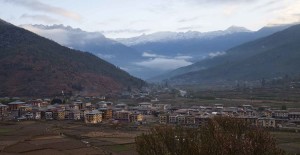
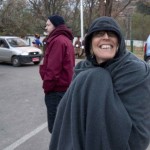
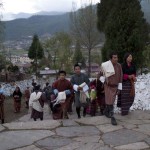
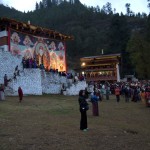
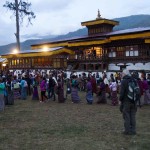
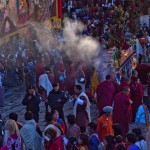
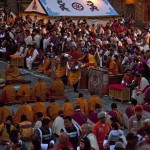
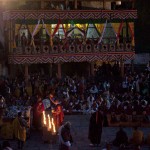
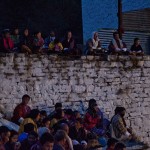
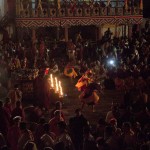
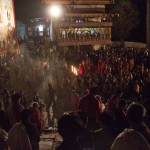
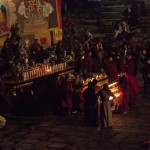
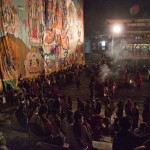
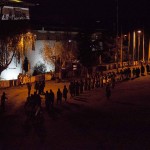
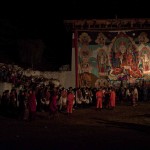
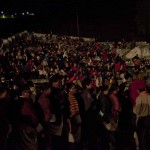
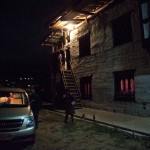
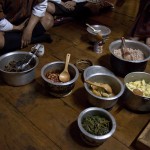
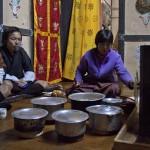
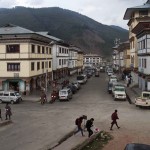
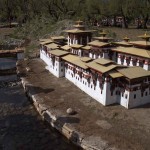
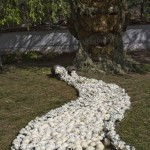
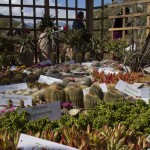
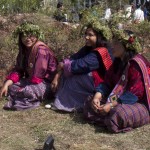
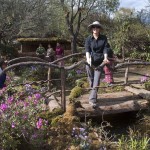
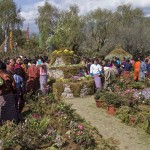
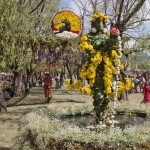
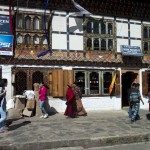
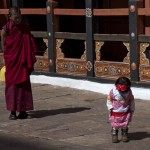
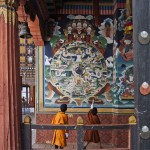
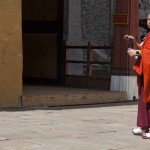

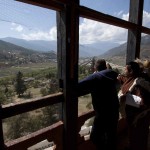
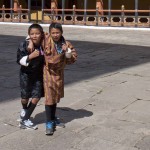
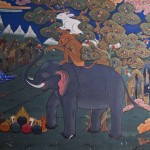
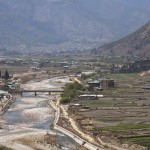
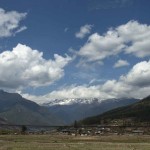
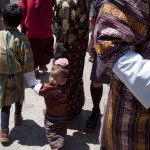
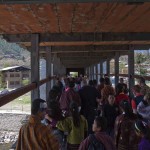
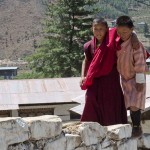
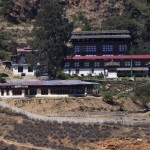
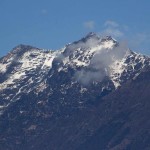
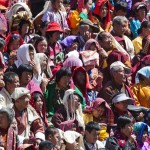
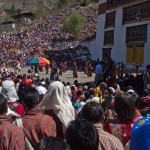
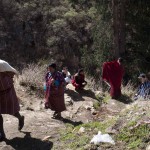
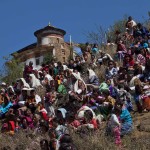
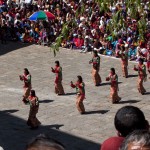
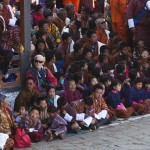
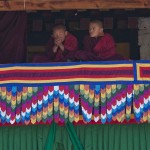
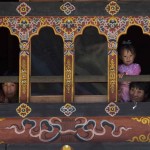
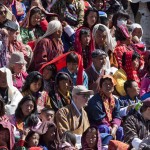
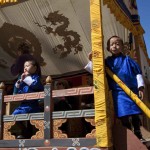
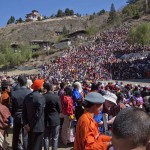
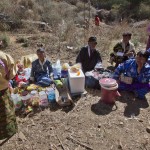
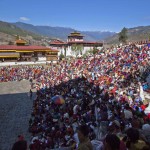
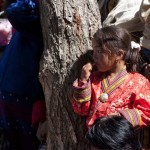
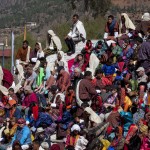
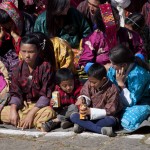
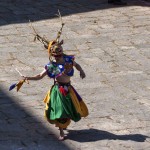
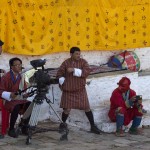
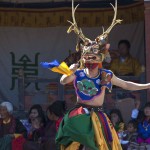
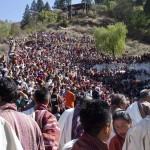
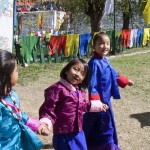
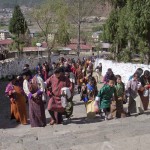
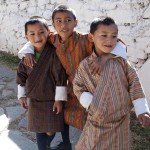
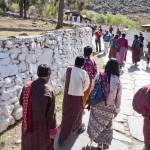
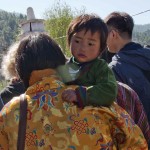
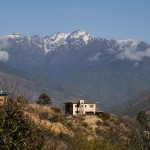
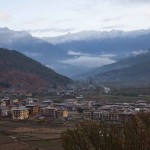
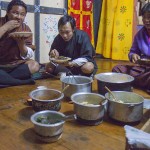
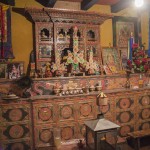
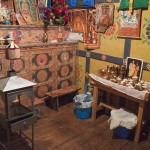
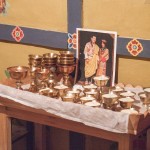
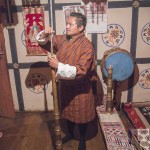
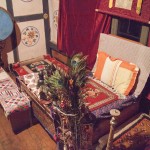
Pingback: Bhutan (Part 1) – Paro – bontaks travels
Pingback: Bhutan (Part 3) – Thimphu – bontaks travels
Pingback: Bhutan (Part 4) – Punakha – bontaks travels
Pingback: Bhutan (Part 6) – Tiger’s Nest Monastery – bontaks travels